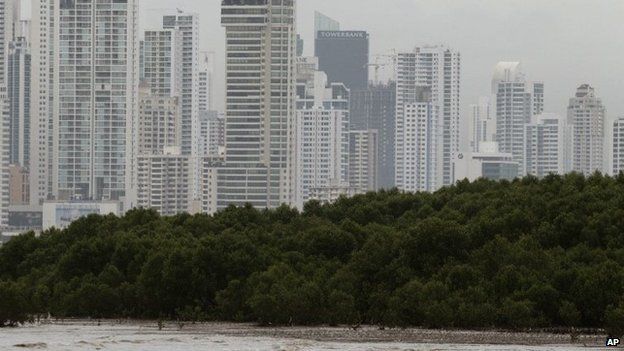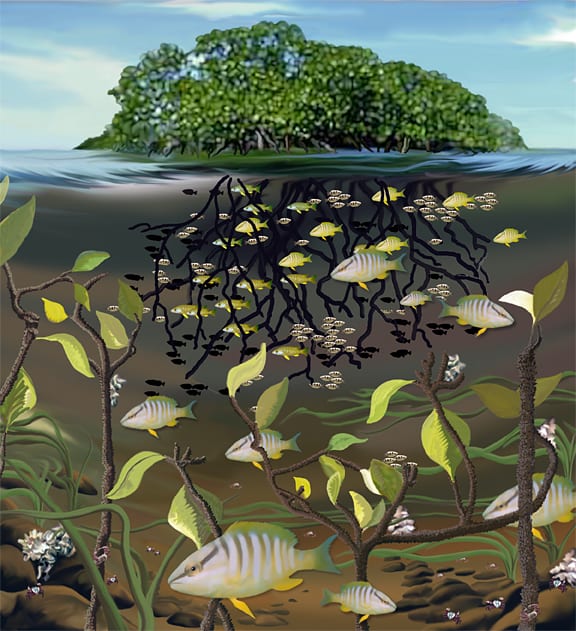Mighty Mangroves: 4 Interesting Facts about these Coastal Marvels
POW! BAM! WOW, LOOK AT THOSE MANGROVES GO!
Mangroves are like nature’s superheroes protecting our cities and environment. These special types of trees are found in estuaries (where fresh water meets salt water) all over the world. There are OVER 50 mangrove species! In the United States, there are three species: Red, White, and Black.
The red mangroves live along the coastline and their roots (aerial props) are a reddish color. They can grow about 80 ft. tall, depending on the area’s temperature. Red mangroves live on the coastline because they can handle the roughest conditions (erosion, heavy storms, and harsh pollution).
Black Mangroves are known for their long horizontal roots (pneumatophores). They grow a little higher on land than the red mangroves. Typically, where the change in water level shows the roots in the air. Black mangroves can grow up to 65 ft. and have dark and scaly roots.
The white mangroves are a little different than the red and black mangroves. These trees live high on land and do not have visible roots, growing up to 50ft.

The three mangrove species have a unique quality. They can remove the excess salt through their roots and leaves. For a healthy life, they have to go through the removal process. In red mangroves, the roots filter the salt. While in black and white mangroves the salt is removed through the glands on its leaves.
The ability to remove salt is not the only superpower mangroves have, it is just the beginning! Here are 4 awesome facts on how mangroves are our coastal cities’ superheroes.
- Mangroves collect MORE carbon than forests.
Mangroves can absorb more carbon than they release into the atmosphere, known as a carbon sink. They can store about 6.4 billion tons of carbon worldwide.
Mangroves grow in muddy oxygen-poor soil, causing their underwater roots to slow down the process that releases CO2. Allowing them to absorb carbon from the atmosphere by storing them inside the roots and leaves. Carbon can stay in the roots and leaves of mangroves for a longer time than most forests.
- Nature’s Cleaners
Mangroves are like nature’s cleaning crew. Their special roots catch all the dirt and pollution floating through. This helps keep the water cleaner and safer for all the animals and plants leaving a safer habitat.
Mangroves are not alone in keeping the waters clean. These superheroes have a little sidekick called bacteria. The bacteria that surrounds the mangroves collect some of the sediment and pollution. When the mangrove roots are too full, in comes the bacteria to help save the day.
- Mangroves Defenders of Our Cities
These superheroes do not only protect their home, they also protect ours! Mangroves act as a fort for our cities by blocking and slowing down storms.
Their roots and leaves slow down strong winds and waves. This protects our cities from damage caused by flooding, rising sea levels, tsunamis, and erosion. Places where mangroves have protected cities from disasters are West Bengal, India, Shenzhen Bay, China, and the Florida Coast.

- Super Protectors of Animals
There are over 300 different animal species that call mangroves home. Animals such as crabs, flamingos, kingfishers, turtles, monitor lizards, etc.. use mangroves as a form of protection. While in the dry parts of the mangrove forest live tigers, monkeys, and insects.
The large leaves and roots act as protection for prey and hiding spots for their predators. Because of their complex root system several larger animals can visit or use mangroves as their final home or a place to start a new life. Mangroves act as the Circle of Life!

So why do we need to protect mangrove forests?
Along with the 4 reasons above, mangroves provide us with food and medicine. We can use the bark, leaves, and fruits to treat toothaches, stomachaches, and even mosquito repellent.
These mighty superheroes are important in everyone’s life. We must keep them alive and healthy for the future. If you want to help here are ways you and your family can be superheroes and help save mangroves:
- Spread the word on the importance and uniqueness of mangrove forests. Talk to your friends, teachers, and neighbors. Ask if you can do a project on the need for mangrove forests. Make posters or start a mangrove protection club at your school.
- Volunteer at nature conservatories to plant more mangroves. But make sure you plant the correct seeds for the location. For example, in Florida, the Red mangrove is the most common. So it is necessary to plant a native species that can thrive in the location’s climate. Remember, mangroves have over 50 species. Think about the correct species and know your area’s climate abilities.
- Make sustainable choices. DON’T pollute. EAT sustainably sourced food.
The Monterey Bay Aquarium is helping mangroves and you can too! Here, you can purchase Two Tree Pencil. Each pencil purchase pays for a mangrove tree to be planted and maintained.
P.S. There is this cool tool that allows you to see real-time changes happening to mangroves across the world. And stats on restoration, climate/policy, and more. It’s called the Global Mangrove Watch!
Vocabulary Builder:
- Estuaries: an area where freshwater mixes with saltwater
- Pneumatophores: horizontal roots that grow upward out of the mud and water
- Aerial roots: above-the-ground roots that are arched in shape
- Carbon Sink: a natural or fake system that absorbs and keeps large amounts of carbon
- Erosion: soil is worn away and moved due to wind and/or water
